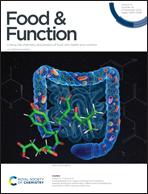Cyanocobalamin promotes muscle development through the TGF-β signaling pathway†
Abstract
Cyanocobalamin (CNCbl, the compound name of Vitamin B12) is the only mineral vitamin that is essential for growth and development and cannot be produced by animals. Some studies have found that CNCbl can promote the proliferation and migration of C2C12 cells, but the mechanism by which it affects muscle development is still unknown. In this study, we elucidated the effect of CNCbl on muscle development and studied its underlying mechanism. CNCbl could promote the differentiation of C2C12 cells and upregulate Acvr1, p-Smad2 and p-Smad3 in the TGF-β signaling pathway in vitro. CD320 (the receptor in cell surface for binding with CNCbl transporter transcobalamin II) inhibition could reduce the uptake of CNCbl and significantly downregulate the expression of differentiation marker proteins MyoG and MYH2. Furthermore, the levels of p-Smad2 and p-Smad3 were also reduced with the inhibition of CD320, even though CNCbl was added to the C2C12 culture medium. In addition, the injection of CNCbl could accelerate the process of mouse muscle injury repair, enlarge the diameter of newly formed myofibers and upregulate the expression of MYH2, PAX7, CD320, Acvr1, p-Smad2 and p-Smad3 in vivo. These results suggest that CNCbl can promote muscle development and may play its role by regulating the expression of Acvr1, p-Smad2 and p-Smad3 related to the TGF-β signaling pathway.



 Please wait while we load your content...
Please wait while we load your content...